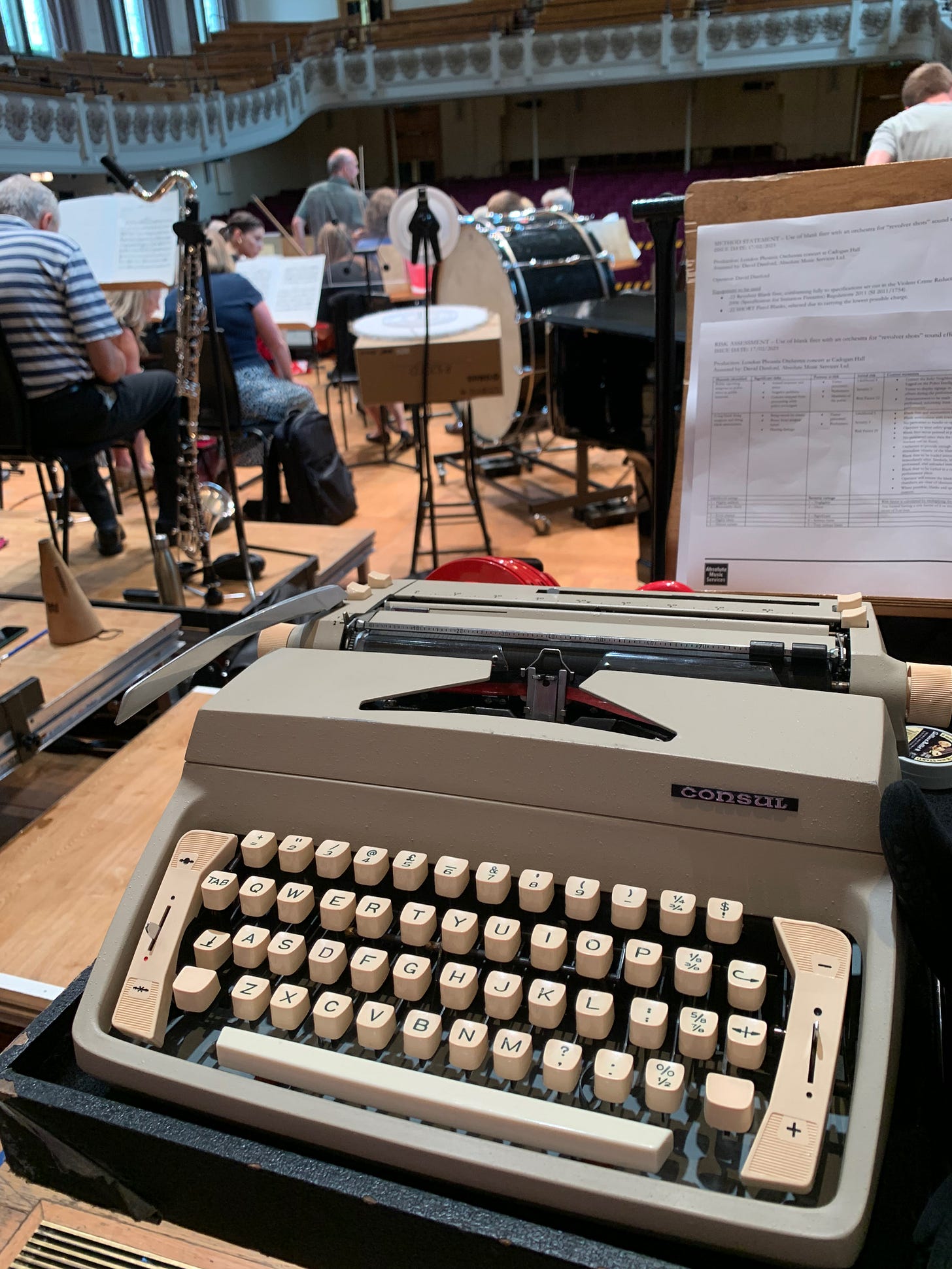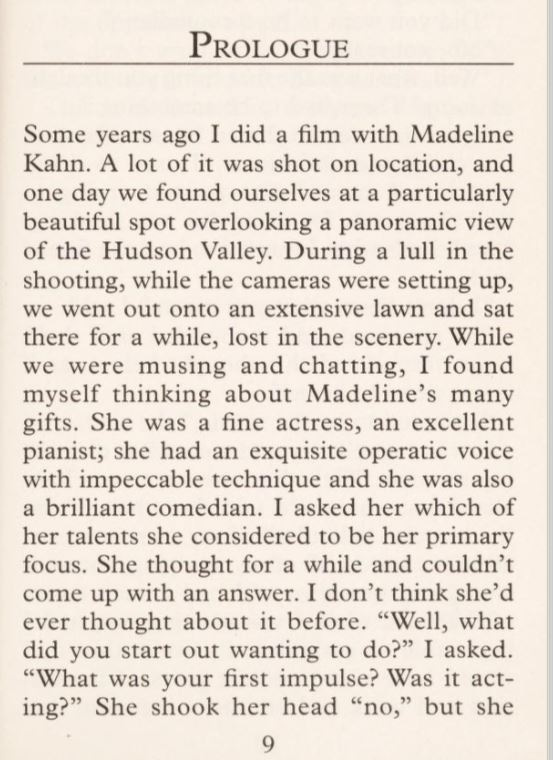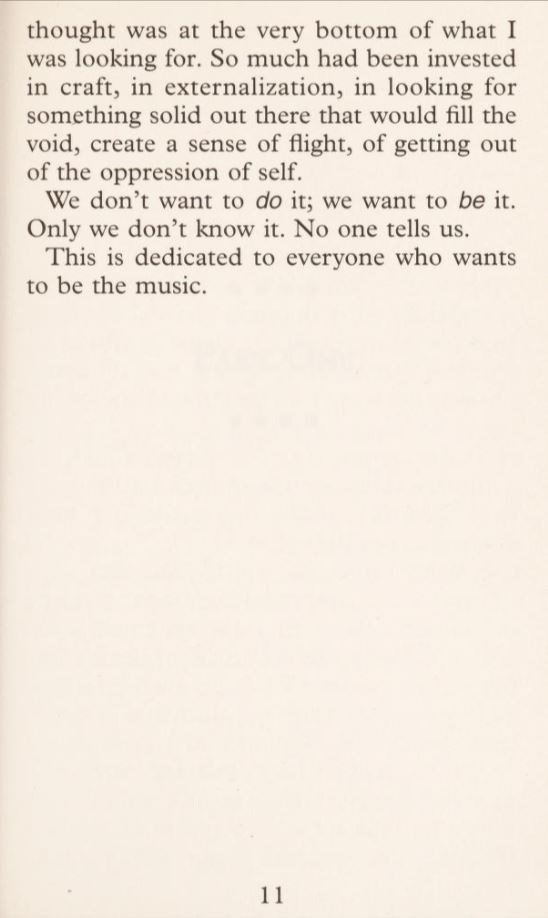Thing 1 – Typewriter
Last Friday, it turns out, was International Typewriter Day. I’m always late to these things. Thankfully, though, Shaun Usher isn’t, and he celebrated it in proper style here.
My acknowledgement of the occasion came (albeit four days late) in a performance I conducted of Erik Satie’s Parade, about which I wrote a couple of months ago. One of Parade’s points of interest is its pioneering use of percussion instruments. We gloss over the sirens, lottery wheel, bottlephone and revolver – they are not relevant to our interests today. Instead we focus on the typewriter, which features in a brief (and necessarily quiet) passage about six minutes in.
Parade was premiered in 1917, so the typewriter used – they were still relatively recent technology – might have looked something like this
Such things are hard and expensive to come by, and I’m not obsessed with ‘authenticity’, so the more modern model was a more than adequate substitute. Thanks to Dave Danford for providing and playing it (with understated aplomb).
The typewriter has since acquired a certain niche status as a novelty instrument. Leroy Anderson famously used it not just as a background noise but as the centrepiece for one of his expertly crafted pieces of light music.
The comic potential of this unusual solo instrument has been fully exploited over the years – some, especially if they’ve seen this performance by Jerry Lewis, might say 'over-exploited'. Anderson’s piece became a comedy turn for several people in the 1950s – I think my favourite is probably this version by Liberace, not least because of the accuracy of the playing (notably absent in the Lewis version).
And of course, in a different arrangement it became the theme tune for the long-running Radio 4 comedy show The News Quiz.
Taking the typewriter’s musical potential to (and perhaps beyond?) its logical conclusion are the Boston Typewriter Orchestra, an ensemble notable for their commitment to a ‘bit’.
Here they are in performance:
For the non-musical, a typewriter can also be used as a drawing tool. Here’s James Cook taking this idea beyond what you might think possible.
And if you’re sculptor Jeremy Mayer, you can take them apart and turn them into birds.
Or you could just use them for their intended purpose, which has of course come a long way since the first working ones were made about 140 years ago.
And to finish off, do you want to see Tom Hanks (who loves old typewriters so much he based a short story collection on them) showing you how to change the ribbon on a typewriter (specifically a Hermes 3000)?
Of course you do.
Thing 2 – Gannets
There are few more entrancing birds than a gannet.
Flying cigars with dagger bills and tapered wedge of a tail, the peachiness of their plumage around the head and neck does a lot for them, as does the particular configuration of facial markings which (anthropomorphising wildly) gives them an air of slightly goofy kindliness.
I could at this point tell you all about the magnificent sight of gannets diving for prey – the way they shear upwards to thirty metres above the water’s surface, do a little banked roll like a Red Arrow peeling off from the formation to enter the dive, slice through the air at a slight angle (all the better to avoid injury when they enter the water), press their wings tight into their sides to gain speed and enter the water more smoothly, close their nostrils and protect their eyes by bringing special second eyelids called nictitating membranes down over their eyeballs, plunge into the water at up to 100 km/h and reach depths of up to 11 metres – but perhaps you can just watch this very short clip instead.
As if that wasn’t enough, the courting behaviour of gannets is endearingly playful.
So if you haven’t fallen for them by now, I don’t quite know what to say to you.
Gannets spend most of the year on the open ocean, gathering in huge colonies for the breeding season. Bass Rock is the largest such colony in the world, and gives the bird its scientific name Morus bassanus.
Unfortunately, like many seabirds, the gannet population has been badly hit by avian flu in the last couple of years. The Bass Rock colony was particularly badly hit.
And here’s an odd phenomenon: gannets normally have light blue eyes, but the eyes of some avian flu survivors turn black. This doesn’t affect their eyesight, but is a reassuring sign of active antibodies in their system. So many odd things in this world.
Seabird populations are being carefully monitored through this breeding season, and early signs from Bass Rock this year are cautiously optimistic.
Fingers, legs, everything crossed for recovering seabird populations everywhere.
Thing 3 – Alan Arkin
RIP Alan Arkin. This, from the prologue to his autobiography (and originally shared on twitter by Kara Calavera), is quite something.
Be the music.
Thing 4 – Pigeon
A footnote – a very funny footnote – to last week’s post about pigeons.
Thing 5 – Password
This new game from Neal Agarwal is brilliant/horrible. Let me know how far you get.
Thing 6 – Hurdling
There is an idea that’s gone around the place for a while that all sport would be improved and enlivened by the presence of a normal person competing alongside the professionals.
This delicious fantasy came close to realisation in the European Athletics Team Championships the other day, when Belgium were unable to field a specialist in the 100-metres hurdles. All they needed to do was to field someone – anyone – to score a point, so the team’s shot putter, Jolien Boumkwo, stepped in, staying in her lane throughout and obviously having a brilliant time. More of this kind of thing.













What a magical set of things. Thank you!!!
I used to own a miniature, ‘portable’ corona!
Gannets are fabulous.
I wanted to be colour.
Madeleine Kahn is famous for saying (when approached by her fiancé in Rocky Horror Show) “No tongues!” Still makes me cackle.
“To be the music” – speechless at the perfection of that concept 👌. Thank you. And gannets are wonderful, as are boobies, the privilege of watching a synchronised performance over an early morning shoal is a deep abiding memory.
I didn’t know about the eye colour change, that’s amazing. And I also have everything crossed for recovery.